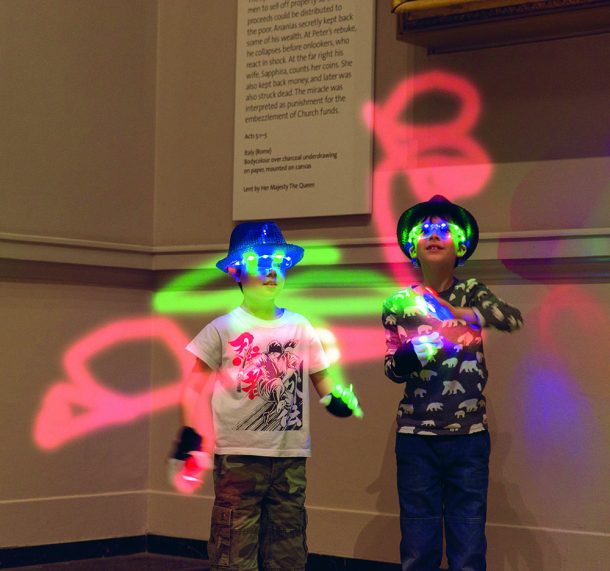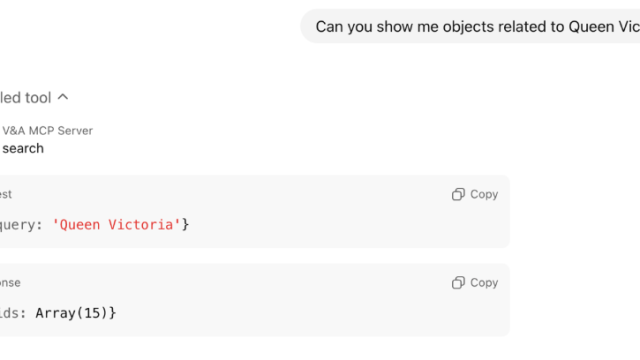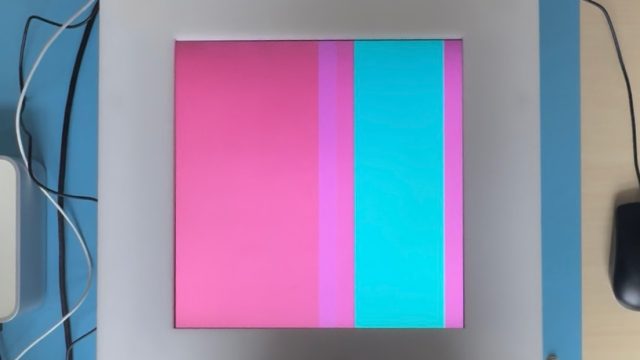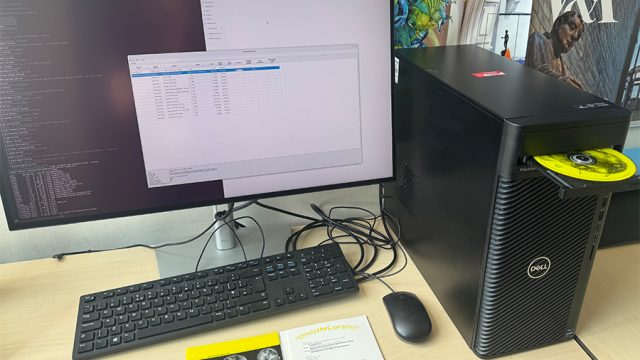Art isn’t just entertaining or decorative. It is life-giving.
These wise words were spoken by Vincent Nichols, the Archbishop of Westminster, after he saw the Sistine Chapel’s awe-inspiring tapestries united for the first time with their original life-size studies: the Raphael Cartoons. Even the great artist himself never saw his magnificent paintings next to the finished tapestries. In this seminal moment back in 2010 at the V&A, the Archbishop’s proclamation articulated art’s life-enriching power.
Art and design, with their complex visual, material, cultural and social meanings, can inspire, amaze, stimulate, educate, alleviate and facilitate. But this comes not just from observing creative masters, who refine their craft into works of perfection. This ‘life-giving’ force springs equally from each simple act of imagination, design, creation and experimentation – something we encourage and observe every day at the V&A. There is extraordinary happiness and satisfaction in designing and creating. It is a fundamental human desire. These life-enriching qualities are boundless, a universal source of great personal joy and fulfilment. They are also the building blocks for essential life skills such as resilience, confidence, self-expression and motivation, and a powerful tool for positive social change.
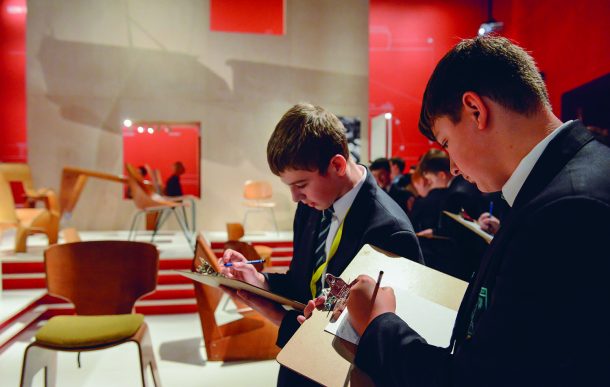
What is more, participation in arts activities has far-reaching benefits spanning seemingly unconnected facets of life. The Cultural Learning Alliance recently reported that learning through arts and culture can increase cognitive abilities and improve attainment in other subjects such as maths and English. It also found that students who study arts subjects are more likely to get a degree, more likely to stay in employment, more likely to vote and more likely to report good health. An American study similarly discovered that the arts foster scientific success: the more accomplished a scientist is, the more likely they are to have an artistic hobby. The breadth of these positive appraisals are compelling.
Equally persuasive is the recognition that by studying arts subjects, people develop the vital skills needed for future jobs. The arts make us more employable and are set to make us even more so in the future. Nesta’s 2017 report The Future of Skills: Employment in 2030 ranked skills according to those most likely to lead to job growth in the UK. It prioritised judgement and decision-making, fluency of ideas, active learning, learning strategies and originality abilities, all developed by studying arts subjects.
Demand for these essential future skills is only expected to grow in the face of workplace automation, which the Bank of England has predicted could cause the loss of 15 million British jobs. But the human brain is far more imaginative, intuitive, better at persuasion, empathy, original thought and storytelling than computers. With the realities of everyday artificial intelligence now clearly on the horizon, our unique creativity is an immunisation against this robotic takeover.
In fact, by 2030 there are projected to be one million new creative jobs, with 1,000 new jobs created every week. The UK’s creative industries are thriving. The sector is the fastest growing part of the UK’s economy, and British creativity is globally coveted. With this demand for design skills extending way beyond the creative industries, employers right across the UK economy – from construction and engineering to IT and finance – are relying on a creative workforce for their future success.
However, just as the case for creative education is most compelling, just as creative jobs are in record demand and the sector is celebrated globally, creativity’s place in our schools looks most uncertain. This troubling state of affairs is at once highly perplexing and deeply concerning. In 2015 – 16 there was a decline of 8% in arts GCSE entries in the UK. This dropped by a further 9% between 2016 and 2017. This means that since the introduction of the English Baccalaureate (EBacc) performance measure in 2010, which downgrades creative subjects from its national assessment criteria, arts GCSE uptake has fallen by 28%. The rippling effects of this educational demotion are now being revealed. A recent BBC survey found that a staggering nine in 10 schools have cut back on lesson time, staff or facilities in at least one creative subject. The widespread perception created among teachers, parents and young people is that the arts do not equate with success. Of course, nothing could be further from the truth. With GCSE entries for arts subjects at their lowest level in a decade, there is a real danger of us destroying something we are very good at.
I believe that museums have a civic duty to fill this void, and at the V&A we have decided to take a stand. As the national museum of art, design and performance, born of the 19th-century design school movement, the V&A has a social and cultural imperative to address this crisis. True to our founding mission, we understand the importance of nurturing creative and technical ability. We want the V&A to be a national incubator for creativity and 21st-century design skills. Using the museum’s outstanding collections and harnessing our innovative and inclusive learning expertise, we want to create a place where the next generation of creative leaders, designers, makers, innovators and entrepreneurs can thrive.

So we are actively reinvesting in young people’s creative futures, supporting all forms of museum learning across our sites. We champion the value of object-based learning, reaching over 400,000 learners in 2016 – 17. We use our beautiful and intriguing objects to tell the story of art and design, and to inspire contemporary makers and designers. As the late Sir Anthony Caro, one of the world’s great sculptors, once declared: ‘We artists go to the V&A for sustenance.’ We provide a safe place for creative endeavour. Just as they did over 100 years ago, today’s creators endlessly draw on the V&A for admiration and inspiration.
But our ambition is now much greater. Over the coming five years, when it comes to the future of design and technology, the V&A will become the natural home in the UK for innovative teaching aids and digital resources, collections-based learning, continuing professional development for teachers, educational partnership for local authority museums and a research hub and best-practice centre for design and technology education.
With design and technology (D&T) GCSE uptake suffering the most – a reduction of 43% since 2010 – we have initiated DesignLab Nation to support the teaching of the relaunched D&T GCSE. This programme is linking up with regional museums, secondary schools and local industry in communities with a strong manufacturing heritage facing the challenge of globalisation. Our aim is to support students by investing in the educational and curatorial provision of local museums, assisting the professional development of teachers and sharing our collections. Object loans are now on display at Blackburn Museum and Art Gallery and Coventry Transport Museum, and from September our pilot programme will extend to Sheffield, Stoke-on-Trent and Sunderland. DesignLab Nation is led by local practitioners from across the creative industries, supporting and encouraging design thinking through hands-on making and practical workshops. As the original site for the Government School of Design in the 1840s, we are proud to return to the V&A’s founding purpose.
With so much less space for creativity in our schools, and school leaders ready to dismiss it as ‘marginal’, we aim to return the lifeblood of design teaching. We are championing the haptic power of objects, encouraging experimentation and problem-solving, and inspiring curiosity. Museums should not be afraid. We shouldn’t confine our great learning programmes to museum walls; we should use our civic capital to make a difference in communities which need our cultural capital the most. Arts subjects have for too long been viewed as the soft option in schools, and we at the V&A are ready to expel the myth that art and design are ‘just entertaining or decorative’. Creativity is fuelling our economy, securing our futures, and making our lives richer. Creativity is certainly life-giving.
